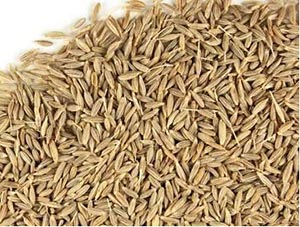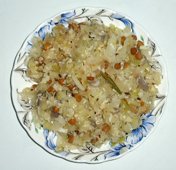Cumin seeds Nutrition facts
Widely popular for their distinctive savory flavor, cumin seeds are one of the routinely featured ingredients in North African, Middle-East, Western Chinese, Indian, Cuban, and North Mexican cuisine. The spice is native to the Middle-East Asian region, and today, grown all over the world for its pleasantly aromatic seeds.
Cumin is a small flowering herbaceous plant belonging to the Apiaceae, family, of the genus; Cuminum. Scientific name is Cuminum cyminum.
 |
| Cumin seeds. |
The cumin plant flourishes well in sandy, fertile soil, assisted with hot summer weather conditions. It bears small, gray-yellow, oblong-shaped seeds with vertical ridges on its outer surface. The seeds closely resemble caraway seeds in appearance.
Cumin seeds impart distinctive strong flavor and warm perception on taste buds. It comes from a particular group of essential oils in them. The chief constituent and important aromatic compound in the seeds is cuminaldehyde (4-isopropyl benzaldehyde).
Black cumin (Bunium persicum), also popular as wild or shahi jeera in the Persian and Indian sub-continent, is a related variety of regular cumin. Its seeds feature long, slender, curved, dark-brown pods with a distinctive earthy flavor.
Health benefits of Cumin seeds
Cumin seeds contain many phytochemicals that are known to have antioxidant, carminative, and anti-flatulent properties. The seeds are an excellent source of dietary fiber.
Its seeds contain certain health benefiting essential oils such as cuminaldehyde (4-isopropyl benzaldehyde), pyrazines,
2-methoxy-3-sec-butyl pyrazine, 2-ethoxy-3-isopropyl pyrazine, and 2-methoxy-3-methylpyrazine.
The active principles in the cumin may improve gut motility and help in digestion by augmenting gastrointestinal juice (enzyme) secretions.
The spice is an excellent source of minerals like iron, copper, calcium, potassium, manganese, selenium, zinc, and magnesium. Copper is required in the production of red blood cells. Iron is essential for red blood cell formation. Zinc is a co-factor in many enzymes that regulate growth and development, digestion, and nucleic acid synthesis. Potassium is an important component of cell and body fluids that helps control heart rate and blood pressure. The human body uses manganese as a cofactor for the important antioxidant enzyme, superoxide dismutase.
It also contains very good amounts of B-complex vitamins such as thiamin, vitamin B-6, niacin, riboflavin, and other vital anti-oxidant vitamins like vitamin E, vitamin A, and vitamin C.
The seeds are also a rich source of many flavonoid phenolic antioxidants such as carotenes, zeaxanthin, and lutein.
Cumin seeds contain many phytochemicals that are known to have antioxidant, carminative, and anti-flatulent properties. The seeds are an excellent source of dietary fiber.
Its seeds contain certain health benefiting essential oils such as cuminaldehyde (4-isopropyl benzaldehyde), pyrazines, 2-methoxy-3-sec-butyl pyrazine, 2-ethoxy-3-isopropyl pyrazine, and 2-methoxy-3-methylpyrazine.
The active principles in the cumin may improve gut motility and help in digestion by augmenting gastrointestinal juice (enzyme) secretions.
The spice is an excellent source of minerals like iron, copper, calcium, potassium, manganese, selenium, zinc, and magnesium. Copper is required in the production of red blood cells. Iron is essential for red blood cell formation. Zinc is a co-factor in many enzymes that regulate growth and development, digestion, and nucleic acid synthesis. Potassium is an important component of cell and body fluids that helps control heart rate and blood pressure. The human body uses manganese as a cofactor for the important antioxidant enzyme, superoxide dismutase.
It also contains very good amounts of B-complex vitamins such as thiamin, vitamin B-6, niacin, riboflavin, and other vital anti-oxidant vitamins like vitamin E, vitamin A, and vitamin C.
The seeds are also a rich source of many flavonoid phenolic antioxidants such as carotenes, zeaxanthin, and lutein.
| Principle | Nutrient Value | Percent of RDA |
|---|---|---|
| Energy | 375 Kcal | 19% |
| Carbohydrates | 44.24 g | 34% |
| Protein | 17.8 g | 32% |
| Total Fat | 22.27g | 74% |
| Cholesterol | 0 mg | 0% |
| Dietary Fiber | 10.5 g | 26% |
| Vitamins | ||
| Folates | 10 µg | 2.5% |
| Niacin | 4.58 mg | 28.5% |
| Pyridoxine | 0.435 mg | 33% |
| Riboflavin | 0.32 mg | 24.5% |
| Thiamin | 0.628 mg | 52% |
| Vitamin A | 1270 IU | 42% |
| Vitamin C | 7.7 mg | 13% |
| Vitamin E | 3.3 mg | 22% |
| Vitamin K | 5.4 µg | 4.5% |
| Electrolytes | ||
| Sodium | 1788 mg | 38% |
| Potassium | 68 mg | 11% |
| Minerals | ||
| Calcium | 931 mg | 93% |
| Copper | 0.867 mg | 96% |
| Iron | 66.36 mg | 829% |
| Magnesium | 366 mg | 91% |
| Manganese | 3.3 mg | 145% |
| Phosphorus | 499 mg | 71% |
| Zinc | 4.8 mg | 43.5% |
| Phyto-nutrients | ||
| Carotene-ß | 762 µg | -- |
| Crypto-xanthin-ß | 0 µg | -- |
| Lutein-zeaxanthin | 448 µg | -- |
Selection and storage
Cumin spice can be readily available around the year in the market. You can buy its seeds as well as ground powder in ready-made packs. Good-quality cumin should release a pleasant yet peppery flavor when squeezed between index and thumb fingers. In the stores, buy whole seeds instead of powder since oftentimes it may contain adulterated inferior quality spice mixtures.
The seeds can be stored in a cool, dry, dark place, in airtight containers for many months, and can be milled using a hand-mill as and when required. Ground and powdered cumin should be stored in the refrigerator in air-sealed containers and should be used as early as possible since it loses its flavor quickly.
Medicinal uses
Its seeds are employed to prepare a decoction to treat flatulence and indigestion in traditional medicines.
The seeds are being used in traditional medicines to stave off common cold symptoms. (Medical disclaimer).
Culinary uses
Cumin is generally toasted/roasted gently before adding to a recipe. In order to keep its fragrance and flavor intact, it is generally milled just before preparing dishes.
 |
| Cabbage stir-fry spiced with green chili, cumin seeds, and mustard seeds. |
-
It is widely used as a spice and employed in cooking as a condiment and flavoring base.
Its seeds have been in use since ancient times in the preparation of many popular dishes in Mediterranean, Asian, and Chinese cuisines. Along with other spicy items, it is being used as a flavoring agent in chicken, fish, and meat dishes.
Some Indian vegetarians (jeera daal, aaloo-jeera), chicken curries, and rice dishes (biryani, pulao) use cumin on a regular basis. The spice is also a favorite in the Middle East, especially in meat and rice dishes.
The seeds are also been used in the preparation of soups, barbecue sauces, pickling, and as one of the ingredients in a variety of curry powders.
In India and Pakistan, cumin seeds are employed extensively in the food industry in the preparations of candies, condiments, appetizers, and soft drinks (Jal-jeera, aam panna, etc.).
Black cumin (kala-jeera) seeds are popular spice ingredients in Persian and Mughlai cuisine.
Safety profile
Cumin seeds should be used in limited amounts as food. Too many spices in the food can cause gastrointestinal irritation, indigestion, and stomach ulcers.(Medical disclaimer).
≻≻-Back to Spices from Cumin. Visit here for an impressive list of healthy spices with complete illustrations of their nutrition facts and health benefits.
≻≻-Back to Home page.
Further reading:
USDA National Nutrient Database.(opens in new window)
Gernot-Katzer's spice pages. (Opens in new window).